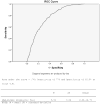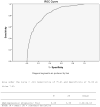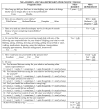Identifying at-risk dementia caregivers following institutionalization: the nursing home admission-burden and nursing home admission-depression prognostic tools
- PMID: 24965720
- PMCID: PMC4076154
- DOI: 10.1177/0733464812454008
Identifying at-risk dementia caregivers following institutionalization: the nursing home admission-burden and nursing home admission-depression prognostic tools
Abstract
The current study developed prognostic tools to identify dementia caregivers at-risk for clinically relevant burden or depressive symptoms following nursing home admission (NHA) of their family members. A retrospective, longitudinal design was used that included 1,610 dementia caregivers who provided data prior to and up to 6 months following nursing home admission. Response operant characteristic (ROC) curves were constructed to test and validate two prognostic tools: the NHA-Burden and NHA-Depression tools. An ROC curve yielded a sensitivity of 77% and a specificity of 62.5% at a cutoff score of 5.41 for the NHA-Burden Prognostic tool. A second ROC curve indicated a sensitivity of 75.4% and a specificity of 62.5% at a cutoff score of 7.45 for the NHA-Depression tool. Clinicians may wish to utilize cutpoints on the NHA-Burden and NHA-Depression tools to ensure that more persons who are at-risk for clinically significant burden or depression during NHA are identified.
Keywords: Alzheimer’s disease; caregiving; dementia; nursing homes; stress.
© The Author(s) 2012.
Figures




Similar articles
-
Clinically significant changes in burden and depression among dementia caregivers following nursing home admission.BMC Med. 2010 Dec 17;8:85. doi: 10.1186/1741-7015-8-85. BMC Med. 2010. PMID: 21167022 Free PMC article.
-
The effects of incident and persistent behavioral problems on change in caregiver burden and nursing home admission of persons with dementia.Med Care. 2010 Oct;48(10):875-83. doi: 10.1097/MLR.0b013e3181ec557b. Med Care. 2010. PMID: 20733529
-
Predictors of change in caregiver burden and depressive symptoms following nursing home admission.Psychol Aging. 2009 Jun;24(2):385-96. doi: 10.1037/a0016052. Psychol Aging. 2009. PMID: 19485656 Free PMC article.
-
Caregiver burden among dementia patient caregivers: a review of the literature.J Am Acad Nurse Pract. 2008 Aug;20(8):423-8. doi: 10.1111/j.1745-7599.2008.00342.x. J Am Acad Nurse Pract. 2008. PMID: 18786017 Review.
-
Caregivers of Alzheimer's patients and factors influencing institutionalization of loved ones: some considerations on existing literature.Ann Ig. 2013 May-Jun;25(3):235-46. doi: 10.7416/ai.2013.1926. Ann Ig. 2013. PMID: 23598807 Review.
Cited by
-
A Pilot Evaluation of Psychosocial Support for Family Caregivers of Relatives with Dementia in Long-Term Care: The Residential Care Transition Module.Res Gerontol Nurs. 2015 Jul-Aug;8(4):161-72. doi: 10.3928/19404921-20150304-01. Epub 2015 Mar 10. Res Gerontol Nurs. 2015. PMID: 25751083 Free PMC article. Clinical Trial.
-
Factors contributing to the mental health outcomes of carers during the transition of their family member to residential aged care: a systematic search and narrative review.BMC Geriatr. 2022 May 17;22(1):433. doi: 10.1186/s12877-022-03105-4. BMC Geriatr. 2022. PMID: 35581539 Free PMC article. Review.
-
Always on alert: How relatives of family members with dementia experience the transition from home to permanent nursing home placement.Nurs Open. 2023 Sep;10(9):6300-6308. doi: 10.1002/nop2.1877. Epub 2023 Jun 21. Nurs Open. 2023. PMID: 37345273 Free PMC article.
-
The ResidentialCare Transition Module: a single-blinded randomized controlled evaluation of a telehealth support intervention for family caregivers of persons with dementia living in residential long-term care.BMC Geriatr. 2020 Apr 15;20(1):133. doi: 10.1186/s12877-020-01542-7. BMC Geriatr. 2020. PMID: 32293314 Free PMC article. Clinical Trial.
-
Mixed-methods single-arm repeated measures study evaluating the feasibility of a web-based intervention to support family carers of persons with dementia in long-term care facilities.Pilot Feasibility Stud. 2018 Oct 31;4:165. doi: 10.1186/s40814-018-0356-7. eCollection 2018. Pilot Feasibility Stud. 2018. PMID: 30410783 Free PMC article.
References
-
- Almberg B, Grafstrom M, Krichbaum K, Winblad B. The interplay of institution and family caregiving: Relations between patient hassles, nursing home hassles and caregivers’ burnout. International Journal of Geriatric Psychiatry. 2000;15:931–939. - PubMed
-
- Aneshensel CS, Pearlin LI, Mullan JT, Zarit SH, Whitlatch CJ. Profiles in caregiving: The unexpected career. San Diego: Academic Press; 1995.
-
- Brody E. Long-term care of older people: A practical guide. New York: Human Sciences Press; 1977.
-
- Czaja SJ, Gitlin LN, Schulz R, Zhang S, Burgio LD, Stevens AB, Gallagher-Thompson D. Development of the Risk Appraisal Measure: A brief screen to identify risk areas and guide interventions for dementia caregivers. Journal of the American Geriatrics Society. 2009;57(6):1064–1072. doi: 10.1111/j.1532-5415.2009.02260.x. - DOI - PMC - PubMed

